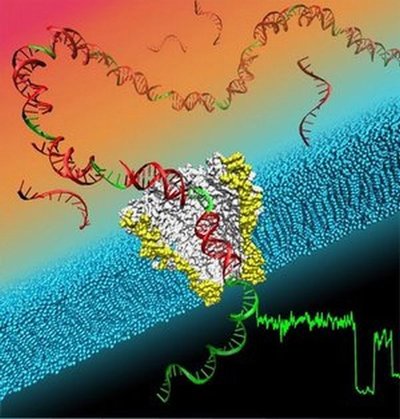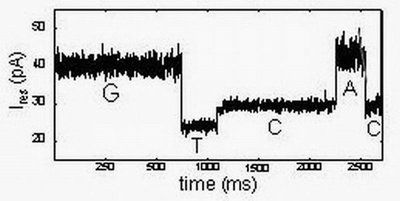August 19, 2010
Nanoscale DNA sequencing could spur revolution in personal health care
In experiments with potentially broad health care implications, a research team led by a UW physicist has devised a method that works at a very small scale to sequence DNA quickly and relatively inexpensively.
That could open the door for more effective individualized medicine, for example providing blueprints of genetic predispositions for specific conditions and diseases, such as cancer, diabetes or addiction.
“The hope is that in 10 years people will have all their DNA sequenced and this will lead to personalized, predictive medicine,” said Jens Gundlach, a UW physics professor and lead author of a paper describing the new technique published the week of Aug. 16 in the Proceedings of the National Academy of Sciences.
The technique creates a DNA reader that combines biology and nanotechnology using a nanopore taken from Mycobacterium smegmatis porin A. The nanopore has an opening 1 billionth of a meter in size, just large enough to measure a single strand of DNA as it passes through.
The scientists placed the pore in a membrane surrounded by potassium-chloride solution. A small voltage was applied to create an ion current flowing through the nanopore, and the current’s electrical signature changed depending on the nucleotides traveling through the nanopore. Each of the nucleotides that are the essence of DNA — cytosine, guanine, adenine and thymine — produced a distinctive signature.
The team had to solve two major problems. One was to create a short and narrow opening just large enough to allow a single strand of DNA to pass through the nanopore and for only a single DNA molecule to be in the opening at any time. Michael Niederweis at the University of Alabama at Birmingham modified the M. smegmatis bacterium to produce a suitable pore.
The second problem, Gundlach said, was that the nucleotides flowed through the nanopore at a rate of one every millionth of a second, far too fast to sort out the signal from each DNA molecule. To compensate, the researchers attached a section of double-stranded DNA between each nucleotide they wanted to measure. The second strand would briefly catch on the edge of the nanopore, halting the flow of DNA long enough for the single nucleotide to be held within the nanopore DNA reader. After a few milliseconds, the double-stranded section would separate and the DNA flow continued until another double strand was encountered, allowing the next nucleotide to be read.
The delay, though measured in thousandths of a second, is long enough to read the electrical signals from the target nucleotides, Gundlach said.
“We can practically read the DNA sequence from an oscilloscope trace,” he said.
Besides Gundlach and Niederweiss, other authors are Ian Derrington, Tom Butler, Elizabeth Manrao and Marcus Collins of the UW; and Mikhail Pavlenok at Alabama-Birmingham.
The work was funded by the National Institutes of Health and its National Human Genome Research Institute as part of a program to create technology to sequence a human genome for $1,000 or less. That program began in 2004, when it cost on the order of $10 million to sequence a human-sized genome.
The new research is a major step toward achieving DNA sequencing at a cost of $1,000 or less.
“Our experiments outline a novel and fundamentally very simple sequencing technology that we hope can now be expanded into a mechanized process,” Gundlach said.


